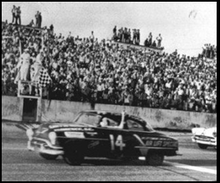|
1952 Southern 500
 The 1952 Southern 500, the third running of the event, was a NASCAR Grand National Series event that was held on September 1, 1952, at Darlington Raceway in Darlington, South Carolina. BackgroundDarlington Raceway, nicknamed by many NASCAR fans and drivers as "The Lady in Black" or "The Track Too Tough to Tame" and advertised as a "NASCAR Tradition", is a race track built for NASCAR racing located near Darlington, South Carolina. It is of a unique, somewhat egg-shaped design, an oval with the ends of very different configurations, a condition which supposedly arose from the proximity of one end of the track to a minnow pond the owner refused to relocate. This situation makes it very challenging for the crews to set up their cars' handling in a way that will be effective at both ends. The track is a four-turn 1.366 miles (2.198 km) oval.[3] The track's first two turns are banked at twenty-five degrees, while the final two turns are banked two degrees lower at twenty-three degrees.[3] The front stretch (the location of the finish line) and the back stretch is banked at six degrees.[3] Darlington Raceway can seat up to 60,000 people.[3] Darlington has something of a legendary quality among drivers and older fans; this is probably due to its long track length relative to other NASCAR speedways of its era and hence the first venue where many of them became cognizant of the truly high speeds that stock cars could achieve on a long track. The track allegedly earned the moniker The Lady in Black because the night before the race the track maintenance crew would cover the entire track with fresh asphalt sealant, in the early years of the speedway, thus making the racing surface dark black. Darlington is also known as "The Track Too Tough to Tame" because drivers can run lap after lap without a problem and then bounce off of the wall the following lap. Racers will frequently explain that they have to race the racetrack, not their competition. Drivers hitting the wall are considered to have received their "Darlington Stripe" thanks to the missing paint on the right side of the car. Race reportSeven cautions were waved for forty laps in front of 32,400 audience members.[2] The race's speed was 74.512 miles per hour (119.915 km/h) and 88.550 miles per hour (142.507 km/h) as the pole position speed.[2] This race was constantly threatened to be postponed because of rain and was red flagged once because of actual rainfall.[4] It took six hours, forty-two minutes, and thirty-seven seconds for the race to reach its conclusion, making it the longest Southern 500 ever; Fonty Flock was the winner.[2] He would stop on the front straight, climb up on his hood and lead the entire crowd in singing his own version of the classic Southern American song Dixie.[4] Flock's uniform would consist of Bermuda shorts and argyle socks in addition to a pencil-thin moustache reminiscent of Clark Gable.[5][6] Total winnings for this race were $23,855 ($273,705 when adjusted for inflation). Sixty-six drivers competed; all of them were born in the United States.[2] Jim Paschal was the last place driver of the race; finishing in 66th with an engine problem on lap 18. Jimmy Ingram flipped his vehicle over on lap 91. In four attempts this was Tommy Thompson's best finish at Darlington.[2] There were 12 different manufacturers in this race.[2] Johnny Patterson's awesome 2nd place finish in his second start would prove to be his best in the Cup series.[2] As well as the best finish for owner H.B. Ranier, father of Harry Ranier.[2] Ranier-Lundy Racing and Petty Enterprises were the only non-independent racing teams to show up for this race.[7] Tony Bonadies, Johnny Bridgers, Merritt Brown, Johnny Gouveia, Keith Hamner, Possum Jones, Pete Kelly, Banjo Matthews and Joe Weatherly made their NASCAR Grand National Series debut in this event. Roy Hall, Rudy Hires, Jimmy Ingram, Bill Miller, E. C. Ramsey and Rollin Smith would never race in professional stock car racing after this race. W. E. Baker, Al Conroy, Al Fleming and Herb Fry would make their only NASCAR appearances at this race.[8] Red Vogt, Julian Buesink and B.B. Blackburn were the three notable crew chiefs at this event.[9] Finishing orderSection reference:[2]
TimelineSection reference:[2]
References
|
|||||||||||||||||||||||||||||||||||||||||||||||||||||||||||||||||||||||||||||||||
Portal di Ensiklopedia Dunia
